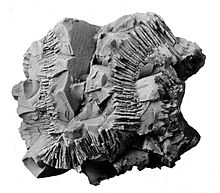
Back بيرولوسيت Arabic Pirolüzit AZ Піралюзіт BE Пиролузит Bulgarian Piroluzit BS Pirolusita Catalan Pyroluzit Czech Pyrolusit German Πυρολουσίτης Greek Pirolusita Spanish
| Pyrolusite | |
|---|---|
 | |
| General | |
| Category | Oxide minerals |
| Formula (repeating unit) | MnO2 |
| IMA symbol | Pyl[1] |
| Strunz classification | 4.DB.05 |
| Crystal system | Tetragonal |
| Crystal class | Ditetragonal dipyramidal (4/mmm) H-M symbol: (4/m 2/m 2/m) |
| Space group | P42/mnm |
| Identification | |
| Color | Darkish, black to lighter grey, sometimes bluish |
| Crystal habit | Granular to massive: botryoidal. Crystals rare |
| Twinning | {031}, {032} may be polysynthetic |
| Cleavage | Perfect on 110 |
| Fracture | Irregular/Uneven |
| Tenacity | Brittle |
| Mohs scale hardness | 6–6.5, 2 when massive |
| Luster | Metallic, dull to earthy |
| Streak | Black to bluish-black |
| Specific gravity | 4.4–5.06 |
| Refractive index | Opaque |
| References | [2][3][4][5] |
| Major varieties | |
| Polianite | pseudomorphic after manganite[6] |
Pyrolusite is a mineral consisting essentially of manganese dioxide (MnO2) and is important as an ore of manganese.[7] It is a black, amorphous appearing mineral, often with a granular, fibrous, or columnar structure, sometimes forming reniform crusts. It has a metallic luster, a black or bluish-black streak, and readily soils the fingers. The specific gravity is about 4.8. Its name is from the Greek for fire and to wash, in reference to its use as a way to remove tints from glass.[5]

- ^ Warr, L.N. (2021). "IMA–CNMNC approved mineral symbols". Mineralogical Magazine. 85 (3): 291–320. Bibcode:2021MinM...85..291W. doi:10.1180/mgm.2021.43. S2CID 235729616.
- ^ Mineralienatlas
- ^ Barthelmy, David (2014). "Pyrolusite Mineral Data". Webmineral.com. Retrieved 4 August 2022.
- ^ "Pyrolusite". Mindat.org. Retrieved 4 August 2022.
- ^ a b Anthony, John W.; Bideaux, Richard A.; Bladh, Kenneth W.; Nichols, Monte C. (2005). "Pyrolusite" (PDF). Handbook of Mineralogy. Mineral Data Publishing. Retrieved 14 March 2022.
- ^ "Polianite". Mindat.org. Retrieved 4 August 2022.
- ^ Reidies, Arno H. (2002), "Manganese Compounds", Ullmann's Encyclopedia of Industrial Chemistry, vol. 20, Weinheim: Wiley-VCH, pp. 495–542, doi:10.1002/14356007.a16_123, ISBN 978-3-527-30385-4.